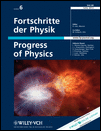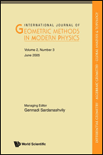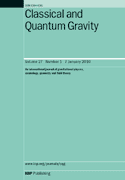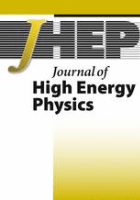
Gravitation & Cosmology
Scope & Guideline
Elevating Understanding of Gravitational Phenomena
Introduction
Aims and Scopes
- Gravitational Theories and Models:
The journal extensively covers various theories of gravity, including General Relativity, Modified Gravity (e.g., f(R) gravity), and Quantum Gravity. It explores both classical and contemporary models of gravity and their implications in cosmology. - Black Hole Physics:
Research on black holes is a significant focus area, including studies on their formation, thermodynamics, properties, and interactions. Topics such as black hole shadows, stability, and quantum aspects are frequently discussed. - Cosmological Dynamics:
The journal features studies on the dynamics of the universe, including the expansion, evolution, and structure formation. This includes theoretical models, observational constraints, and implications of dark energy and dark matter. - Quantum Aspects of Gravitation:
There is a growing interest in the intersection of quantum mechanics and gravitation, particularly in understanding quantum effects in strong gravitational fields and their implications for cosmology. - Mathematical and Theoretical Physics:
Papers often delve into the mathematical foundations of gravitational theories, including soliton solutions, stability analyses, and the geometrical aspects of spacetime.
Trending and Emerging
- Interplay between Quantum Mechanics and Gravity:
An increasing number of papers are exploring the connections between quantum mechanics and gravitational theories, particularly in contexts like black holes and early universe cosmology, highlighting the quest for a unified theory. - Dark Energy and Dark Matter Studies:
Research on dark energy and dark matter remains a dominant theme, with new approaches and models being proposed to explain their roles in cosmic evolution and structure formation. - Complex and Anisotropic Cosmological Models:
There is a trend towards investigating more complex models of the universe, including anisotropic and inhomogeneous cosmologies, which offer insights into the universe's structure and behavior on various scales. - Advanced Mathematical Techniques in Gravity:
Papers utilizing sophisticated mathematical frameworks, such as algebraic structures, tensor calculus, and numerical simulations, are becoming more prevalent, reflecting a trend towards rigorous mathematical treatments of gravitational theories. - Wormhole and Exotic Spacetime Studies:
Emerging interest in traversable wormholes and other exotic spacetime structures indicates a growing curiosity about unconventional solutions in general relativity and their potential implications for astrophysics and cosmology.
Declining or Waning
- Classical Cosmology Models:
There seems to be a decline in papers focusing on traditional models of cosmology, such as simple Friedmann-Lemaître-Robertson-Walker (FLRW) models, as researchers increasingly explore more complex, modified, or non-standard cosmological frameworks. - Static or Non-Dynamic Solutions:
The focus on static or non-dynamic solutions in gravity theories appears to be waning, with a shift towards dynamic models that incorporate time-dependent behaviors and interactions. - Phenomenological Approaches:
There is a noticeable reduction in purely phenomenological studies that do not significantly advance theoretical understanding or provide new insights into gravitational phenomena, as the community moves towards more fundamental theoretical frameworks.
Similar Journals

INTERNATIONAL JOURNAL OF THEORETICAL PHYSICS
Elevating Discourse in Physics and MathematicsInternational Journal of Theoretical Physics is a premier academic journal dedicated to the advancement of knowledge in the fields of theoretical physics and mathematics. Published by Springer/Plenum Publishers, this esteemed journal has been a vital platform for researchers since its inception in 1968. With an impressive track record and an emphasis on high-quality, innovative research, the journal currently ranks in the third quartile (Q3) in both the Mathematics (Miscellaneous) and Physics and Astronomy (Miscellaneous) categories as of 2023. While the journal is not open access, it offers accessible subscription options for institutions and individuals. The International Journal of Theoretical Physics serves as an essential resource for scholars and practitioners looking to deepen their understanding and contribute to the evolving landscape of theoretical research, making it a key player in nurturing academic discourse and fostering collaboration in its field.

Journal of Cosmology and Astroparticle Physics
Connecting Researchers to the Heart of AstrophysicsThe Journal of Cosmology and Astroparticle Physics (ISSN: 1475-7516) is a premier publication in the field of astronomy and astrophysics, dedicated to advancing our understanding of the cosmos through innovative research. Published by IOP Publishing Ltd in the United Kingdom, this journal has established itself as a vital resource for researchers, professionals, and students alike, with an impressive Scopus rank of #11/90, placing it in the top 12% of its field. The journal aims to foster the dissemination of groundbreaking studies related to cosmology, dark energy, particle physics, and the universe's fundamental structure, making it a key player in shaping contemporary astrophysics discourse. With a Category Quartile of Q2 as of 2023, it continues to attract high-quality contributions that enhance scholarly dialogue. As an accessible platform, it engages a diverse audience interested in the frontiers of astrophysical research, encouraging collaboration and knowledge sharing among the global scientific community.

Universe is a distinguished peer-reviewed journal published by MDPI, specializing in the dynamic fields of Physics and Astronomy. Established in 2015, this Open Access journal has rapidly gained recognition, achieving a prestigious Q1 quartile ranking in its category as of 2023. With its E-ISSN 2218-1997, the journal primarily serves the international scientific community, offering a platform for researchers to disseminate innovative ideas and findings. Based in Switzerland, Universe covers a wide range of topics within astronomy and astrophysics, ensuring that cutting-edge research is accessible to an ever-growing audience. Its commitment to open access principles since its inception allows for unrestricted dissemination of knowledge, fostering a collaborative environment essential for scientific advancement. By aligning its objectives with the promotion of high-quality research and interdisciplinary discourse, Universe stands as a vital resource for academics, professionals, and students aiming to contribute to and engage with the ever-evolving landscape of astronomical research.

FORTSCHRITTE DER PHYSIK-PROGRESS OF PHYSICS
Pioneering Insights for the Next Generation of PhysicistsFORTSCHRITTE DER PHYSIK-PROGRESS OF PHYSICS, published by WILEY-V C H VERLAG GMBH, is a prestigious academic journal esteemed within the field of physics. With a history spanning over seven decades since its inception in 1953 and a converged publication up until 2024, this journal has established itself as a leading source for groundbreaking research and developments across diverse domains in physics and astronomy. Holding an influential Q1 ranking in the 2023 category of Physics and Astronomy (miscellaneous), it serves as an essential platform for disseminating high-quality research findings and theoretical advancements. Although not an Open Access publication, FORTSCHRITTE DER PHYSIK provides access to critical insights and scholarly discussions that are pivotal for researchers, professionals, and students alike. The journal is committed to contributing to the evolution of knowledge in physics, supporting the academic community through rigorous peer-reviewed articles, reviews, and innovative studies.

Science China-Physics Mechanics & Astronomy
Bridging Theory and Application in the Physical SciencesScience China-Physics Mechanics & Astronomy, published by SCIENCE PRESS, stands as a prestigious journal within the Physics and Astronomy domain, particularly recognized for its contributions to the understanding of fundamental and applied physics. With an exhilarating Q1 ranking in the 2023 category and earning a remarkable scopus rank of #21 out of 243, the journal demonstrates its significant impact, being positioned in the 91st percentile of its field. Operating under an Open Access model, it facilitates the broad dissemination of high-quality research, ensuring accessibility for researchers, professionals, and students worldwide. Its scope covers a variety of essential topics in physics and astronomy, promoting a comprehensive understanding of the latest advancements from 2010 through 2024. The journal is a vital resource for anyone aiming to stay at the forefront of research in these dynamic fields, with its prominent address located in Beijing, China, symbolizing its global influence.

INTERNATIONAL JOURNAL OF GEOMETRIC METHODS IN MODERN PHYSICS
Illuminating the Geometric Foundations of Theoretical PhysicsINTERNATIONAL JOURNAL OF GEOMETRIC METHODS IN MODERN PHYSICS is a leading academic publication dedicated to the interdisciplinary exploration of geometric methods in the realms of modern physics. Published by WORLD SCIENTIFIC PUBL CO PTE LTD, this esteemed journal is based in Singapore and acts as a critical platform for researchers, professionals, and students seeking to delve into the intricacies of modern theoretical physics and its geometric foundations. With an impressive Scopus ranking placing it in the 64th percentile of its category, the journal highlights innovative research and developments from 2005 to 2024 within its scope. While currently not offering Open Access, it remains a vital resource for the dissemination of valuable knowledge in its field, contributing significantly to the advancement of physics and astronomy. We encourage the academic community to explore this exceptional journal for cutting-edge insights and to further enhance their understanding of geometric applications in modern scientific inquiry.

Physics of the Dark Universe
Exploring the Enigmatic Forces of the UniversePhysics of the Dark Universe is a premier academic journal published by Elsevier, dedicated to advancing the understanding of dark matter, dark energy, and their implications for the universe. With its ISSN N/A and E-ISSN 2212-6864, the journal has established a notable presence since its inception in 2012, operating out of Amsterdam, Netherlands. As evidenced by its impressive impact factor and its ranking in the top quartile in both Astronomy and Astrophysics (Q1) and Space and Planetary Science (Q1) categories for 2023, this journal is a vital resource for researchers and practitioners within these fields. In the latest Scopus ranks, it ranks #12 out of 104 in Earth and Planetary Sciences and #13 out of 90 in Physics and Astronomy, placing it in the 88th and 86th percentiles respectively, underlining its academic significance. The journal is not Open Access, yet it plays an essential role in disseminating high-quality research that pushes the boundaries of knowledge about the cosmos and its most enigmatic components. Researchers, professionals, and students interested in the forefront of astrophysics will find this journal an indispensable tool for staying abreast of emerging discoveries and ongoing debates.

CLASSICAL AND QUANTUM GRAVITY
Bridging Classical and Quantum Perspectives in PhysicsCLASSICAL AND QUANTUM GRAVITY is a prestigious journal published by IOP Publishing Ltd, positioning itself at the forefront of research in the domain of theoretical physics, particularly focusing on gravitational theories in both classical and quantum frameworks. With an impressive Q1 rank in the field of Physics and Astronomy, it has established a significant academic presence since its inception in 1984. This journal offers a platform for disseminating high-quality research findings and critical reviews, playing a pivotal role in advancing our understanding of the foundations of gravitational physics. Researchers and professionals alike will find this scholarly publication an invaluable resource for staying abreast of the latest developments in gravitational theory, quantum gravity, and related interdisciplinary studies. Despite the absence of open access options, its vibrant print and online presence ensures that contributions are accessible to the global scientific community. With a commitment to fostering innovation in an area that remains central to modern physics, CLASSICAL AND QUANTUM GRAVITY continues to attract cutting-edge research that shapes the future of gravitational studies.

JOURNAL OF HIGH ENERGY PHYSICS
Exploring the dynamics of the universe through high energy physics.JOURNAL OF HIGH ENERGY PHYSICS, published by SPRINGER, stands at the forefront of research in the fields of nuclear and high energy physics. With an impressive impact factor and a Scopus ranking of #5 out of 87 in its category, it sits comfortably in the 94th percentile of academic journals worldwide. Since its inception in 1997 and transitioning to Open Access in 2014, the journal has committed itself to the dissemination of peer-reviewed, cutting-edge research that fosters collaboration and innovation across the global scientific community. Located in Germany and reaching audiences worldwide, the journal aims to provide a platform for scholars and researchers to share their findings, thus propelling advancements in theoretical and experimental physics. As it converges into 2024, the JOURNAL OF HIGH ENERGY PHYSICS continues to be an essential resource for anyone engaged in this dynamic field of study.

Nature Astronomy
Illuminating the Universe: High-Impact Findings for the Astronomical Community.Nature Astronomy, published by NATURE PORTFOLIO, stands at the forefront of the field of Astronomy and Astrophysics. Since its inception in 2016, this esteemed journal has rapidly ascended to a prestigious position, achieving a Q1 ranking in the Astronomy and Astrophysics category and securing an impressive 6th place out of 90 journals in the Scopus rankings, placing it in the 93rd percentile. With a focus on disseminating pioneering research, Nature Astronomy provides a vital platform for the dissemination of high-quality, impactful findings across various aspects of astronomical science. Researchers, professionals, and students alike will find a wealth of knowledge and innovative perspectives within its pages, enabling them to stay ahead in a rapidly evolving field. Although it does not offer open access, the journal's commitment to excellence and its influence in shaping the future of astronomical research make it an indispensable resource for anyone serious about advancing their understanding of the cosmos.